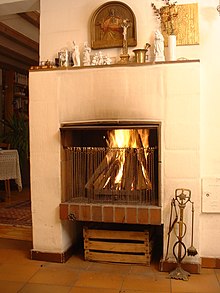
Back Parod AMI Fogar (fuego) AN مستوقد Arabic Llar AST Buxarı AZ Камін BE Камина Bulgarian Llar de foc Catalan Товха CE Krb Czech


A fireplace or hearth is a structure made of brick, stone or metal designed to contain a fire. Fireplaces are used for the relaxing ambiance they create and for heating a room. Modern fireplaces vary in heat efficiency, depending on the design.
Historically, they were used for heating a dwelling, cooking, and heating water for laundry and domestic uses. A fire is contained in a firebox or fire pit; a chimney or other flue allows exhaust gas to escape. A fireplace may have the following: a foundation, a hearth, a firebox, a mantel, a chimney crane (used in kitchen and laundry fireplaces), a grate, a lintel, a lintel bar, an overmantel, a damper, a smoke chamber, a throat, a flue, and a chimney filter or afterburner.[1]
On the exterior, there is often a corbelled brick crown, in which the projecting courses of brick act as a drip course to keep rainwater from running down the exterior walls. A cap, hood, or shroud serves to keep rainwater out of the exterior of the chimney; rain in the chimney is a much greater problem in chimneys lined with impervious flue tiles or metal liners than with the traditional masonry chimney, which soaks up all but the most violent rain. Some chimneys have a spark arrestor incorporated into the crown or cap.
Organizations like the United States Environmental Protection Agency (EPA) and the Washington State Department of Ecology warn that, according to various studies, fireplaces can pose health risks.[2][3] The EPA writes "Smoke may smell good, but it's not good for you."[2]
- ^ Skøtt, Torben (September 2007). "Chimney filters can save billions" (PDF). BioPress. pp. 10–11. Archived (PDF) from the original on February 16, 2021. Retrieved May 13, 2021.
- ^ a b "Wood Smoke and Your Health". United States Environmental Protection Agency. May 28, 2013. Archived from the original on May 14, 2021. Retrieved May 13, 2021.
- ^ Cite error: The named reference
Ecologywas invoked but never defined (see the help page).